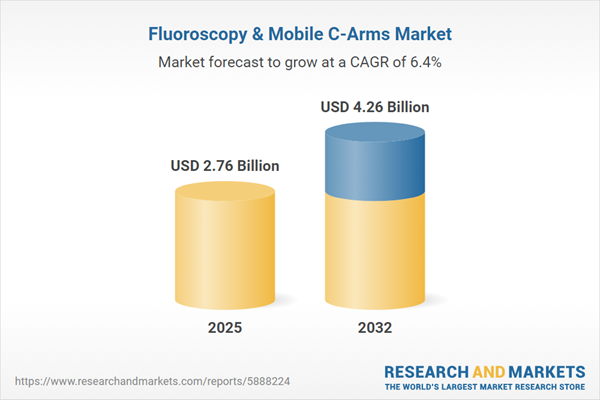Speak directly to the analyst to clarify any post sales queries you may have.
The global fluoroscopy and mobile C-arms market is undergoing rapid transformation as senior healthcare leaders prioritize investment in technologies that streamline imaging processes and ensure regulatory compliance. Positioned at the intersection of clinical performance and operational efficiency, this evolving market demands informed decision-making backed by robust market intelligence.
Market Snapshot: Fluoroscopy and Mobile C-Arms Market
The fluoroscopy and mobile C-arms market is forecast to expand significantly, with the total value rising from USD 2.59 billion in 2024 to USD 2.76 billion by 2025, ultimately projected at USD 4.26 billion by 2032. This growth trajectory, supported by a 6.39% CAGR, is primarily driven by increased requirements for high-definition, real-time imaging in fast-paced clinical environments. Healthcare providers are increasingly adopting systems that boost procedural accuracy and capacity, with investments targeting system upgrades and device interoperability. The drive for modernization supports robust procurement activity across hospitals, ambulatory surgery centers, and diagnostic facilities.
Scope & Market Segmentation
This section defines critical segments, enabling leaders to tailor procurement strategies and optimize planning for advanced imaging investments in diverse care settings:
- Equipment Types: Fixed fluoroscopy systems, mobile C-arms for versatile use, and mini C-arms designed for space efficiency and selective clinical procedures.
- Applications: Cardiology, orthopedics, gastroenterology, and urology—each reflecting specific needs for intraoperative imaging and supporting multispecialty workflows.
- End Users: Hospitals, ambulatory surgery centers, and diagnostic centers; these stakeholders face distinct operational dynamics and procurement challenges influencing adoption rates.
- Technologies: Analog and digital platforms distinguished by integration capability, data sharing enhancements, and tools for comprehensive performance monitoring.
- Image Intensifiers: Flat panel detectors and traditional image intensifiers, assisting leaders in weighing upgrades for improved imaging and cost management.
- Price Ranges: Options spanning cost-effective configurations up to advanced, premium systems, allowing organizations to balance investment with clinical objectives.
- Regions: Americas, Europe, Middle East and Africa, and Asia-Pacific; regional factors such as regulation, infrastructure, and clinical trends directly impact market penetration and procurement approaches.
- Key Companies: Market presence of General Electric Company, Siemens Healthineers AG, Koninklijke Philips N.V., Shimadzu Corporation, Canon Medical Systems Corporation, Ziehm Imaging GmbH, Hologic, Inc., OrthoScan, Inc., Analogic Corporation, and Esaote S.p.A. continues to drive ongoing innovation and solution availability.
Key Takeaways for Senior Decision-Makers
- Integrating digital imaging platforms with real-time data sharing tools streamlines workflow while supporting compliance efforts in complex healthcare environments.
- Compact and AI-enabled device options offer enhanced clinical flexibility, empowering existing facilities to address more complex caseloads without substantial infrastructure changes.
- Adopting cloud-based imaging solutions supports scalable deployment strategies, improving asset utilization and resource management across healthcare networks.
- Flexible procurement models—such as modular upgrades or bundled agreements—increase purchasing responsiveness, helping align technology strategies with evolving operational requirements.
- Regional market dynamics can shape technology selection, with established markets favoring comprehensive systems while emerging areas prioritize mobile, adaptable solutions due to infrastructure factors.
- Targeted investments in ongoing staff education and technical support play a critical role in maximizing uptime and achieving consistent regulatory alignment.
Tariff Impact on Procurement and Supply Chain
Shifting US tariffs have prompted recalibration of acquisition costs across the fluoroscopy and mobile C-arms segment. Manufacturers are diversifying their production bases and supplier networks to minimize supply chain vulnerabilities. For healthcare organizations, proactive strategies such as contract renegotiation, embracing bundled purchasing models, and reinforcing risk management protocols are pivotal in securing technology access despite evolving trade landscapes.
Methodology & Data Sources
This research uses comprehensive secondary data analysis and structured interviews with clinicians, biomedical engineers, and procurement executives experienced with fluoroscopy and mobile C-arm systems. Multiple validation cycles ensure accuracy, relevant segmentation, and practical utility for decision-makers evaluating capital investments for imaging infrastructure.
Why This Report Matters
- Delivers focused guidance for senior executives on investment, procurement, and operational continuity in an advancing market for fluoroscopy and mobile C-arms.
- Allows leaders to synchronize technology choices with organizational objectives, ensuring adaptability in response to shifting care models and reimbursement structures.
- Facilitates agile planning by highlighting pathways for regulatory alignment and future-proof management of imaging assets.
Conclusion
By applying the market insights from this report, organizational leaders can enhance procurement strategies and sustain high standards of clinical efficiency. This guidance supports effective long-term planning amid rapid industry evolution.
Additional Product Information:
- Purchase of this report includes 1 year online access with quarterly updates.
- This report can be updated on request. Please contact our Customer Experience team using the Ask a Question widget on our website.
Table of Contents
3. Executive Summary
4. Market Overview
7. Cumulative Impact of Artificial Intelligence 2025
Companies Mentioned
The companies profiled in this Fluoroscopy & Mobile C-Arms market report include:- General Electric Company
- Siemens Healthineers AG
- Koninklijke Philips N.V.
- Shimadzu Corporation
- Canon Medical Systems Corporation
- Ziehm Imaging GmbH
- Hologic, Inc.
- OrthoScan, Inc.
- Analogic Corporation
- Esaote S.p.A
Table Information
| Report Attribute | Details |
|---|---|
| No. of Pages | 192 |
| Published | October 2025 |
| Forecast Period | 2025 - 2032 |
| Estimated Market Value ( USD | $ 2.76 Billion |
| Forecasted Market Value ( USD | $ 4.26 Billion |
| Compound Annual Growth Rate | 6.3% |
| Regions Covered | Global |
| No. of Companies Mentioned | 11 |









